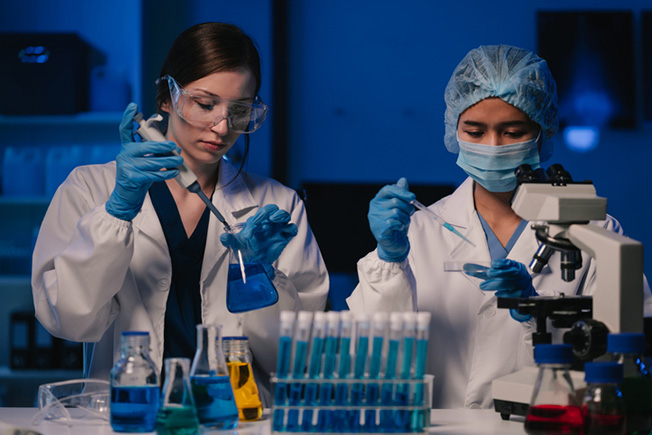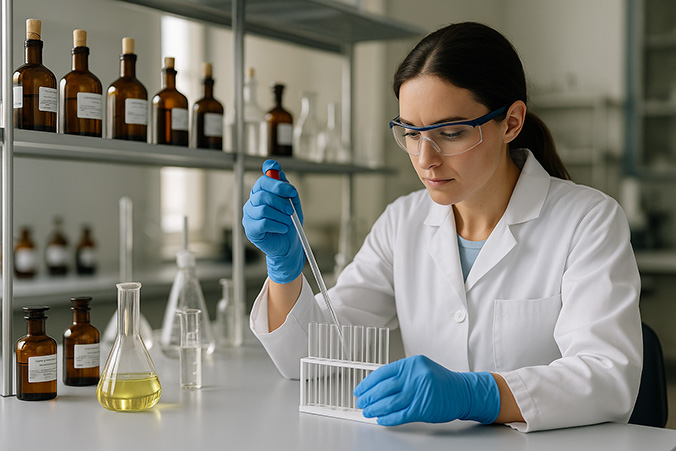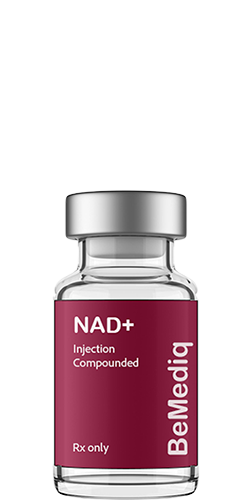Understanding how regulation, personalization, and evidence shape modern hormone therapy — and why women deserve clarity, not confusion.

1. The Confusion Around Bioidentical HRT
Few words in women’s health have been as misunderstood — and misused — as bioidentical hormone replacement therapy (BHRT).
Some imagine it means “natural,” others assume it’s “unsafe.”
The term has carried hope, skepticism, and marketing hype all at once — yet at its core, bioidentical hormones describe something beautifully simple: hormones that mirror the ones your body already knows.
Bioidentical hormones are chemically identical to those naturally produced by the human body, including estradiol, estriol, and progesterone.
A brief history about bioidentical HRT helps explain the confusion.
The earliest use of bioidentical hormones didn’t begin with pharmaceutical companies, but with compounding pharmacies in the 1980s and 1990s.
Long before any FDA-approved formulations existed, pharmacists were preparing individualized prescriptions of USP-grade estradiol, estriol, and progesterone for physicians who sought gentler, more physiologic alternatives to synthetic HRT. At that time, mainstream hormone therapy was dominated by products such as Premarin® (conjugated equine estrogens) and Provera® (medroxyprogesterone acetate)— both effective for symptom relief, yet not structurally identical to human hormones.
Then came a turning point.
In 2002, the Women’s Health Initiative (WHI) — one of the largest clinical studies on hormone therapy ever conducted — linked conventional synthetic HRT (CEE + MPA) with an increased risk of breast cancer, cardiovascular disease, and stroke. The findings sent shockwaves through women’s health, prompting millions to discontinue therapy almost overnight — and ignited a public search for safer, more “natural” alternatives.
In response, pharmaceutical companies introduced their own standardized bioidentical formulations in the early 2000s, including Estrace® (17β-estradiol) and Prometrium® (micronizedprogesterone), offering FDA-approved options made from the same molecular structures used in compounded prescriptions.
Thus, the word “bioidentical” came to describe two parallel systems — one individualized and prepared perprescription, the other standardized and approved through large-scale clinical testing.
Today, the conversation about bioidentical HRT is less about chemistry and more about regulatory frameworks — and women are often left navigating the resulting confusion, trying to understand what’s truly right for them.
Quick Definition: BHRT, cBHRT and FDA-approved BHRT
BHRT (Bioidentical Hormone Replacement Therapy): Use of hormones identical to natural human hormones.
cBHRT (Compounded BHRT): Custom-prepared prescriptions made in licensed compounding pharmacies.
FDA-approved BHRT / MHT: Standardized, mass-produced hormone therapies tested and approved by health authorities (branded or generic).
2. Why Compounded Bioidentical Hormones Still Exist

No two women experience hormonal change in exactly the same way.
For one, mood and sleep may shift long before periods become irregular; for another, migraines oranxiety appear seemingly out of nowhere.
These differences are not imagined — they reflect how uniquely each body metabolizes and responds to hormones.
Some women are sensitive to certain fillers or delivery forms.
Others need micro-adjusted doses that cannot be achieved with standardized pharmaceutical options.
In these cases, compounded bioidentical hormone therapy (cBHRT) provides a way to individualize treatment — tailoring the dose, form, and route of delivery to a woman’s specific physiology, under physician supervision.
For example:
- A woman with migraines may respond better to a transdermal cream rather than an oral tablet.
- Someone with sensitive skin might require a base free of preservatives or alcohol.
- Another may benefit from a gradual, micro-titrated protocol that allows smoother hormonal adaptation.
Compounded hormones are not meant to replace FDA-approved therapies, but to complement them —particularly when standardized products don’t meet a patient’s unique therapeutic requirements.
3. The Regulatory Bias About Bioidentical HRT — FDA-Approved vs. Compounded
The ongoing debate around bioidentical HRT has little to do with the hormones themselves — and much to do with how they are regulated.
Organizations such as the FDA in the U.S. and the EMA in Europe often caution against compounded bioidentical hormones (cBHRT) — not because the ingredients are unsafe, but because individualized formulations cannot be tested in large, population-based clinical trials in the same way as standardized pharmaceuticals.
This distinction is primarily regulatory — it reflects how medicines are approved, not whether they are medically appropriate. It rests on two valid but distinct systems of quality control:
- FDA-approved bioidentical HRT (branded or generic) — validated through clinical trials, standardized manufacturing, and (c)GMP oversight.
- Compounded bioidentical HRT (cBHRT) — regulated through pharmacy practice laws and USP <795>, <797>, and <800> standards that govern purity, sterility, and dosing accuracy for each prescription. Each formulation is made under a physician’s prescription and tailored to the woman’s clinical needs.
When prescribed and monitored by a qualified clinician, compounded hormones fall within legitimate medical practice and professional ethics.
Yet because they are prepared per individual prescription rather than mass-produced, they fall outside the drug-approval model that most regulatory agencies rely on.
In short:
- FDA-approved bioidentical HRT means the product is validated by the FDA through large-scale trials and manufacturing oversight.
- Compounded bioidentical HRT means the process and pharmacy are regulated under state and federal quality standards.
Both pathways aim to ensure quality, consistency, and patient safety — they simply operate under different systems of oversight.
Understanding the distinction is only half the story; the real question is why health authorities still place greater trust in standardized therapies — and how that shapes what women ultimately have access to.
4. Compounded versus FDA-Approved Bioidentical Hormones — Same Molecule, Different Systems
At first, hearing that both compounded and FDA-approved bioidentical hormones use the same molecules sounds simple — almost identical.
But everything that happens between the raw hormone and the finished product makes the real difference: how it’s prepared, how it’s absorbed, and how itsconsistency is verified.
Both compounded and FDA-approved bioidentical hormones start from the same molecular base — estradiol, estriol, and progesterone — yet they differ in how they are produced, standardized, and monitored for quality.
a. Active Ingredient — The Hormone Itself
The active ingredient( API) is the hormone — the essential flour of the recipe.
In FDA-approved medications, every batch goes through a rigorous approval process to confirm its purity and stability under current Good Manufacturing Practice (cGMP) rules.
Compounding pharmacies also use high-quality USP-grade hormones —pharmaceutical-grade ingredients that meet United States Pharmacopeia (USP) purity standards — though they may source them from different suppliers or lots.
Both adhere to strong safety and quality standards, yet their verification pathways differ: one follows centralized factory oversight, the other relies on the precision and accountability of a licensed pharmacist.
b. Absorption and Delivery — How the Body Receives the Hormone
Even with the same hormone molecule, absorption depends largely on how the formulation is built —its base, particle size, solubility, and stabilizers all influence how the hormone enters the bloodstream.
FDA-approved products have published pharmacokinetic data showing how much hormone typically reaches the bloodstream, based on standardized testing of absorption and bioavailability.
In these products, the active ingredients are combined with uniform excipients— such as fillers, preservatives, and stabilizers — to ensure shelf life, predictable delivery, and large-scale reproducibility.
Compounded formulations, on the other hand, can be prepared in simpler bases, often free of alcohol, fragrances, or synthetic preservatives — an advantage for women who are sensitive to these ingredients.
Compounded prescriptions are also customized — a physician may request a softer cream for sensitive skin or adjust the dose for migraine-prone women.
This personalization supports comfort and flexibility, but it can’t be standardized across everyone — each preparation is unique and designed for one individual’s needs.
This difference is a bit like baking bread: a traditional baker may use only flour, water, and natural starter, adjusting texture and flavor by hand.
An industrial bakery, on the other hand, adds conditioners or preservatives to make sure every loaf rises and lasts exactly the same way.
Both can make good bread — but the process, ingredients, and intention shape the final result.
c. Preparation and Quality Control — How It’s Made
FDA-approved products are produced in automated facilities where machines measure, fill, and seal each dose under controlled, repeatable conditions.
Compounded hormones are mixed and prepared by hand — carefully, under sterile environments, and according to pharmacy standards (USP <795>,<797>, and <800>). These standards govern both non-sterile and sterile compounding as well as the handling of hazardous drugs.
Every compounded prescription is made for one person. This allows fine-tuning but also small, natural variations that automation removes. It’s a bit like comparing a handcrafted piece to one made on a production line— both can be excellent, but their processes and goals are not the same.
To visualize this, imagine two ways of baking bread.
One follows the traditional sourdough method — the baker measures, observes, and adjusts each loaf by hand.
It takes skill and care, and when done well, the results can be remarkable —but no two loaves are ever exactly alike.
The other is industrial baking — precise, automated, and consistent. Machines mix and bake every loaf under the same controlled conditions, producing identical batches where every variable — temperature, humidity, timing — is programmed and monitored.
Both can produce excellent bread. The difference lies not in the ingredients, but in how the process is guided and repeated.
Hormone therapy works much the same way. The molecules are identical, but the path to the final product is not.
One focuses on adaptability and individual needs; the other, on uniformity and large-scale reliability.
Neither is inherently better — they simply serve different purposes in women’s health.
This contrast between craftsmanship and automation sets the stage for how health authorities interpret safety — and why they tend to place more trust in one system than the other.
5. Why Health Authorities Tend to Favor FDA-Approved Bioidentical HRT
Health authorities are designed to protect populations, not individuals — and that shapes how hormone therapies are viewed.
For regulators, safety must be measurable, repeatable, and consistent across millions of prescriptions.
FDA-approved bioidentical HRT (BHRT) fits that model because it can be standardized, tested in large clinical trials, and monitored for side effects through national reporting systems.
This structure makes it easier to issue clear safety guidelines and public recommendations — something that individualized, case-by-case compounding simply cannot provide on the same scale.
By contrast, compounded bioidentical hormones operate within a clinical model that emphasizes personalization over population data.
Each prescription is unique — prepared for one patient at one time — which means outcomes can’t be aggregated or statistically analyzed in the same way.
From a public-health standpoint, this limits the ability of agencies like the FDA or EMA to verify efficacy or long-term safety, even when the underlying ingredients are identical.
For that reason, official recommendations typically highlight FDA-approved products first.
It is not a judgment about the chemistry of compounded hormones, but a reflection of how the regulatory system is built: to manage public risk through consistency and surveillance, rather than customization.
In short, regulators favor what can be tracked; clinicians favor what can be tailored.
Both perspectives aim to keep women safe — they simply operate at different scales of care.
6. Safety, Purity & Myths About Compounded Bioidentical HRT
Much of the skepticism around compounded bioidentical hormone therapy (cBHRT) comes from the early 2000s — a time when the regulatory framework for pharmacy compounding was still fragmented and inconsistently enforced across the United States.
Back then, there were no unified federal oversight mechanisms; safety and quality controls depended largely on individual state boards of pharmacy, whose standards varied widely.
Without centralized monitoring or standardized documentation requirements, reports occasionally surfaced of inconsistent potency or purity in compounded preparations.
Those historical gaps contributed to the perception that compounded hormones were unreliable or unsafe.
However, that landscape has changed profoundly over the past decade.
Since the Drug Quality and Security Act (DQSA) of 2013, pharmacy compounding has been redefined under strict federal and state oversight.
Pharmacies now operate according to USP <795>, <797>, and <800> standards, which govern every aspect of compounding — from ingredient sourcing and sterility testing to environmental monitoring and documentation — and, when properly implemented, may help minimize variability and enhance overall safety.
These standards are enforced by State Pharmacy Boards, and accredited pharmacies are regularly inspected and audited by independent third-party organizations to verify ongoing compliance.
Importantly, all compounding pharmacies — whether accredited or not — must meet core safety and quality requirements to operate legally. They must:
- hold a valid state license issued by their respective State Pharmacy Board,
- comply with USP <795>, <797>, and <800> standards,
- undergo regular state inspections, and
- maintain meticulous documentation, traceability, and purity testing for every compounded formulation.
Licensed compounding pharmacies document each step of production and maintain rigorous quality controls that in some aspects resemble those used in large-scale pharmaceutical manufacturing.
When prescribed and carefully monitored by qualified clinicians, modern cBHRT may represent a legitimate, individualized approach — offering precise dosing and traceability when prepared under appropriate quality standards and clinical supervision.
It allows physicians to fine-tune treatment based on symptoms, lab data, and patient response rather than relying solely on fixed-dose formulations.
It’s important to clarify:
Compounded does not mean experimental.
Non-FDA-approved does not mean unregulated.
Personalized does not mean unsafe.
Emerging reviews (e.g., Holtorf 2009; L’Hermite 2013) suggest that individualized, physician-supervised hormone therapy may support better tolerance or adherence in some patients compared with standardized regimens; however, evidence remains limited and not conclusive.
7. The Importance of Medical Supervision and Certified Pharmacies
In recent years, social media and wellness marketing have blurred the lines between medically prescribed compounded hormone therapy and self-administered hormone products that claim to be “bioidentical.”
This can create a false sense of safety — as if the label alone were enough.
In truth, authentic compounded bioidentical hormones are prescription-only medicines, developed under physician supervision and prepared by licensed compounding pharmacies that follow strict safety and quality standards.
This partnership between doctor and pharmacist ensures that each formulation is guided by clinical evidence — lab data, medical history, and patient response — rather than guesswork or online trends.
When a hormone product is sold directly online, promoted through social media, or offered without medical prescription, it is not part of legitimate medical compounding, even if it uses the same terminology. Such products may:
- lack validated dosing and purity testing,
- be produced outside certified facilities, and
- bypass the physician’s role in monitoring hormonal balance and long-term safety.
Hormone therapy —even in microdoses — is not a cosmetic choice.
It affects complex endocrine pathways and should always be guided by clinical data, medical expertise, and pharmacy-level precision.
8. Summary: Is cBHRT Safe?
Both FDA-approved and compounded bioidentical hormone therapies are based on the same active molecules — hormones identical to those naturally produced by the body. The key differences lie not in the chemical structure itself, but in the formulation process, consistency of dosing, and the level of regulatory oversight and clinical validation.
FDA-approved bioidentical HRT is standardized, supported by large-scale clinical trials, and manufactured under uniform quality controls. It offers consistency and robust population-level data, and is therefore commonly recommended within conventional medical systems.
Compounded bioidentical hormones, by contrast, are individually prepared in licensed pharmacies for women whose needs cannot be met by standardized doses or ingredients.
When prescribed and monitored by qualified clinicians — and produced according to USP <795>,<797>, and <800> — cBHRT may be an appropriate option for selected patients and may support symptom management when standardized products are not suitable.
9. Key Takeaways
Bioidentical hormones are chemically identical to the body’s own hormones; the key differences between compounded vs. FDA-approved options lie in regulation, preparation, and clinical monitoring.
FDA-approved HRT provides standardized dosing, population-based safety data, and quality oversight under (c)GMP — useful when consistency and long-term evidence are priorities.
Compounded bioidentical HRT (cBHRT) enables personalized dosing and formulations when standardized products do not meet clinical needs; safety and efficacy outcomes depend on prescriber oversight and pharmacy standards
All compounding pharmacies must meet USP <795>/<797>/<800> and state licensing requirements and are subject to State Pharmacy Board inspections for safety, sterility, and traceability.
Accredited pharmacies undergo voluntary third-party audits (e.g., ACHC/PCAB, NABP), signaling quality practices beyond baseline licensing.
Authentic cBHRT is prescription-only. Products sold online or via influencers that claim to be “bioidentical” but lack medical supervision or certified pharmacy oversight are not legitimate compounding and may pose health risks.
Regulatory note (as of 2025): The FDA is reviewing whether certain hormones (estradiol, estriol, progesterone) should be added to the “Difficult to Compound” list; no final decision has been issued.
Safe hormone therapy depends less on labels like “compounded” or “FDA-approved,” and more on evidence-based care, qualified medical supervision, and transparent collaboration between patient, physician, and pharmacy.
FAQ: Frequently Asked Questions about cBHRT
1. Are compounded bioidentical hormones FDA-approved?
No. Compounded bioidentical hormones (cBHRT) are prepared by licensed pharmacies per physician prescription but are not individually evaluated by the FDA.
2. Are FDA-approved and compounded hormones chemically different?
No. Both use bioidentical hormones such as estradiol, estriol and progesterone — the difference lies in manufacturing scale, oversight, and delivery method.
3. Is compounded HRT safe?
When prescribed and prepared under medical and pharmacy-level standards, compounded HRT follows strict USP and DQSA regulations for purity and dosing precision.
4. What’s the safest way to begin hormone therapy?
Always consult a qualified healthcare provider. Therapy should be guided by lab results, medical history, and ongoing follow-up — not online claims or over-the-counter products.
____________________
Editorial Note The information provided in this article is for educational purposes only and should not replace professional medical advice.
_____________________
References
Scientific and Clinical Literature about bioidentical HRT:
- Holtorf, K. (2009). The bioidentical hormone debate: Are bioidentical hormones safer or more efficacious than commonly used synthetic versions? Postgrad Med, 121(1): 73–85. PMID: 19179815, DOI: 10.3810/pgm.2009.01.1949.
- L’Hermite, M. (2013). HRT optimization using transdermal estradiol plus micronized progesterone: a safer HRT. Climacteric, 16(Suppl 1): 44–53. PMID: 23848491, DOI: 10.3109/13697137.2013.808563.
- Stuenkel, C.A., Davis, S.R., Gompel, A., et al. (2015).Treatment of Symptoms of the Menopause: An Endocrine Society Clinical Practice Guideline. J Clin Endocrinol Metab, 100(11): 3975–4011. PMID: 26444994, DOI: 10.1210/jc.2015-2236,
- North American Menopause Society (NAMS). (2022). The 2022 Hormone Therapy Position Statement of The North American Menopause Society. PMID: 35797481, DOI: 10.1097/GME.0000000000002028.
- The National Academies of Sciences, Engineering, and Medicine (NASEM). (2020). The Clinical Utility of Compounded Bioidentical Hormone Therapy: A Review of Safety, Effectiveness, and Use. Washington, DC: The National Academies Press. DOI: 10.17226/25791.
- Women’s Health Initiative (WHI) Investigators. (2002). Risks and benefits of estrogen plus progestin in healthy postmenopausal women: Principal results from the Women's Health Initiative randomized controlled trial. JAMA, 288(3): 321–333. DOI: 10.1001/jama.288.3.321.
- American College of Obstetricians and Gynecologists (ACOG). (2023). Compounded Bioidentical Menopausal Hormone Therapy. Committee Opinion No. 532. Obstet Gynecol. Reaffirmed 2023.
Regulatory and Quality References:
- U.S. Congress. (2013). Drug Quality and Security Act (DQSA), Public Law 113–54, Title I: Compounding Quality Act. Enacted November 27, 2013. Available at: https://www.congress.gov/bill/113th-congress/house-bill/3204.
- U.S. Food and Drug Administration (FDA). (2025). Human Drug Compounding – Section 503A of the Federal Food, Drug, and Cosmetic Act. Available at: https://www.fda.gov/drugs/human-drug-compounding/section-503a-federal-food-drug-and-cosmetic-act.
- U.S. Pharmacopeia. USP Compounding Standards: USP <795>, <797>, and <800>. Rockville, MD: U.S. Pharmacopeial Convention; 2023. Available at: https://www.usp.org/compounding.
- National Association of Boards of Pharmacy (NABP). (2025). About State Boards of Pharmacy. Accessed 2025. Available at: .https://nabp.pharmacy/boards-of-pharmacy/
- Accreditation Commission for Health Care (ACHC). PCAB Accreditation Standards for Compounding Pharmacies. Revised 2023. Available at: https://achc.org/pcab/.
Historical and Cultural Context about Compounded Bioidentical Hormone Therapy
- Lee, T.S. (1996). What Your Doctor May Not Tell You About Menopause: The Breakthrough Book on Natural Progesterone. New York: Warner Books. ISBN: 978-0446671443.
- Wright, J.V., & Lenard, J. (1997). Stay Young & Sexy with Bio-Identical Hormone Replacement: The Science Explained. Petaluma, CA: Smart Publications. ISBN: 978-1884956629.
- Somers, S. (2004). The Sexy Years: Discover the Hormone Connection — The Secret to Fabulous Sex, Great Health, and Vitality for Women and Men. New York: Crown Publishers. ISBN: 978-1400051431.
Disclaimer: These statements are for informational purposes only and have not been evaluated by the Food and Drug Administration. This content is not intended to diagnose,treat, cure, or prevent any disease. Always consult a licensed healthcare provider before starting any supplement or therapy.

Written by Elena B.,Women's Wellness Coach
About the Author: Elena B. is an Integrative Health Educator (non-clinical) with a background in holistic health, hormonal resilience, and longevity science. Her mission is to help women reconnect with their biology, understand their cycles, and make empowered lifestyle choices - without medical claims or therapeutic prescriptions.


























